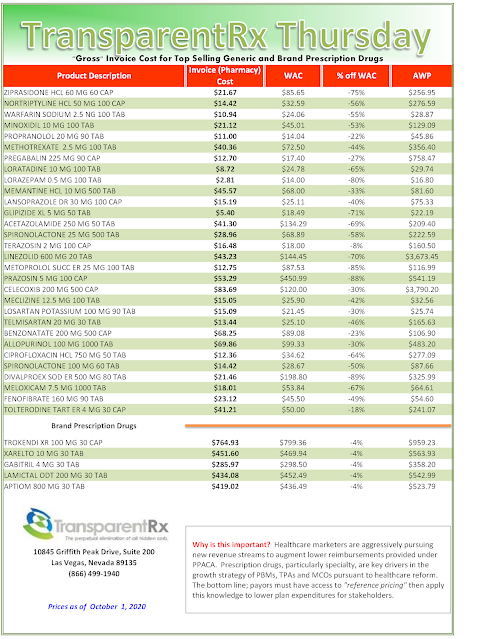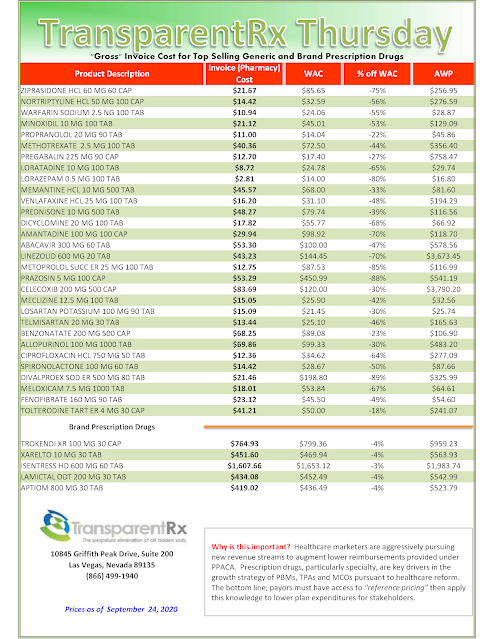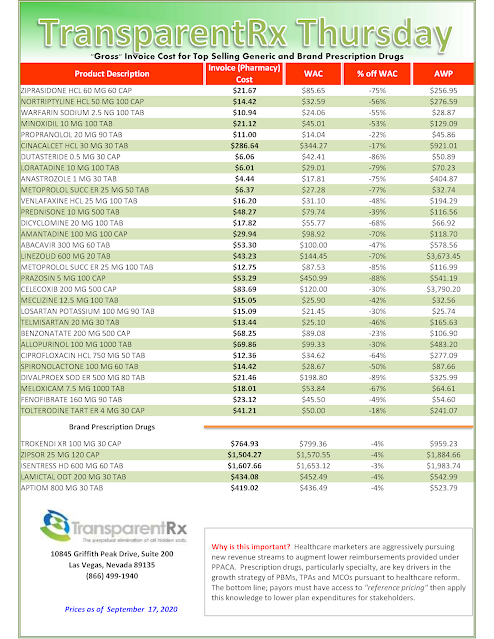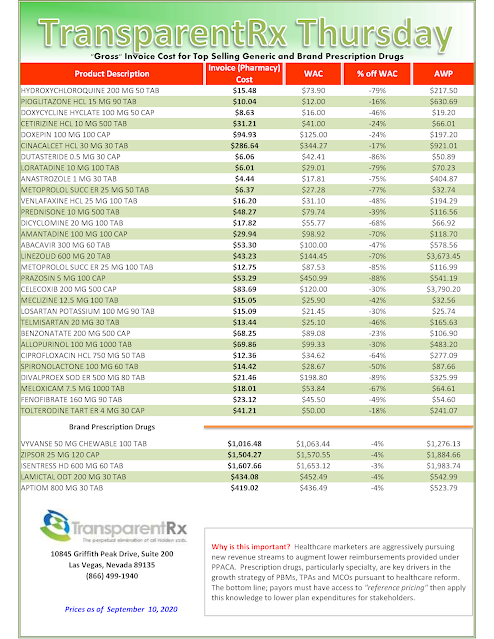Reference Pricing: “Gross” Invoice Cost vs. AWP for Popular Generic and Brand Prescription Drugs (Volume 333)
Step #4: Now take it one step further. Check what your organization has paid, for prescription drugs, against our acquisition costs then determine if a problem exists. When there is more than a 5% price differential for brand drugs or 25% (paid versus actual cost) for generic drugs we consider this a potential problem thus further investigation is warranted.
Multiple price differential discoveries mean that your organization or client is likely overpaying. REPEAT these steps once per month.
— Tip —
Tuesday Tip of the Week: PBMs can be Fiduciaries
It’s not important to me who is right or wrong. I’m focused on making sure plan sponsors get the right information. Ohio’s Attorney General in 2019 called for PBMs to be fiduciaries. Still there is doubt among commercial and public sector employers, unions, health plans and health systems whether a PBM can act as a fiduciary. Very few purchasers of PBM services are asking for a fiduciary model in their pharmacy benefits management request for proposals, for instance.
Pass-through and transparent PBM business models don’t inherently eliminate wasteful and duplicative spending. Because these models thrive on optics and not delivering lowest net cost, they can leave plan sponsors mired in the status quo. In their middleman role, PBMs have used secrecy and subterfuge to pad their own profits instead of passing savings along to customers. John Paul Jones wrote, “It seems to be a law of nature, inflexible and inexorable, that those who will not risk cannot win.”
 |
| Click to Learn More |
“When state agencies entered into these nebulous deals with PBMs, they unknowingly hired a fox to guard the henhouse,” Yost said. “But he was a smart fox. He didn’t kill the chickens; he helped himself to the eggs.” The attorney general recommended “a solution based on market principles” identifying four objectives that should be met:
1) State drug purchases should go through a master PBM contract that is administered through a single point of contact.
2) The Ohio Auditor of State should have unrestricted authority to review all PBM drug contracts, purchases and payments.
3) PBMs must be fiduciaries.
4) Nondisclosure agreements (NDAs) on drug pricing with the state must be prohibited.
What was the broker or consultant’s role in that situation? There are situations where you have someone who is trying to prove that they’re valuable by trying to play hardball with people and spin it as if they are looking out for you. On March 15, 2019 AG Yost filed suit against OptumRx on behalf of the Ohio Bureau of Workers’ Compensation seeking to recover nearly $16 million in overcharges to the fund intended to protect injured workers.
Drugmakers Push Back on the Use of Contract Pharmacies by 340B Covered Entities
With October deadlines in the rear-view, hospitals and health systems that participate in the 340B drug pricing program are scrambling to respond to a flurry of new audit demands from drug manufacturers, as well as manufacturer limitations on the number of contract pharmacies that these covered entities are allowed to use under 340B. Manufacturers and providers participating in the 340B Drug Pricing Program have entered into a new phase of tensions this summer, as manufacturers push back on the use of contract pharmacies by providers.
Additionally, beginning in June, some manufacturers sent letters to providers, directing them to upload contract pharmacy claims data for 340B-eligible prescriptions to the vendor 340B ESP to minimize duplicate discounts for claims that are submitted to Medicaid, Medicare Part D, and commercial payors. 340B administrator entities responded by sending communications to the same providers, reminding them of the confidentiality and data privacy obligations governing the claims data, and refusing to provide authorization to disclose data for payors other than Medicaid.
One manufacturer’s announced refusal to sell drugs for shipment to contract pharmacies is the strongest stance on this issue so far. This announcement will require a response from HRSA (the agency endorsed the use of contract pharmacies in a 2010 regulatory notice), which may ultimately lead to a court battle on the question whether the use of contract pharmacies is permissible under the 340B Program.
Drug companies have become more emboldened in recent weeks to restrict sales to contract pharmacies as legal experts say the Trump administration lacks authority to crack down on the drug companies. Merck, Sanofi and Novartis have called for contract pharmacies to submit claims in order to avoid duplicative discounts. Back in July, Lilly restricted sales to contract pharmacies of three formulations of the erectile dysfunction drug Cialis.
Tyrone’s Commentary:
That pharmaceutical companies would incorporate more compliance initiatives into the 340B program should come as no surprise. Some hospitals were pocketing the savings from 340B discounts instead of offsetting patient out-of-pocket costs, for example. This is only the beginning. First, drug manufacturers clamped down on rebate aggregators and their submission of duplicate or unqualified claims for rebates. Now, the focus has shifted to the use of contract pharmacies by 340B covered entities. Next, I presume drug manufacturers will shift their focus to the abuse of copay maximizer and manufacturer assistance programs. There is no long-term substitute for being an astute caretaker of your employer-sponsored pharmacy benefit plan.
Pharmaceutical companies are targeting a popular tool used by hospitals in the 340B program, which requires drug companies to provide discounts to safety-net hospitals in exchange for participation in Medicaid. Roughly one-third of the more than 12,000 340B hospitals use a contract pharmacy to dispense the discounted drugs, according to a 2018 report from the Government Accountability Office.
The GAO report found that the Health Resources and Services Administration, which oversees the 340B program, does not fully assess compliance with the program’s prohibition on duplicate discounts for drugs prescribed to both Medicaid and 340B. Pharmaceutical manufacturers have also charged that the discount program has gotten too large and unwieldy.
Reference Pricing: “Gross” Invoice Cost vs. AWP for Popular Generic and Brand Prescription Drugs (Volume 332)
Step #4: Now take it one step further. Check what your organization has paid, for prescription drugs, against our acquisition costs then determine if a problem exists. When there is more than a 5% price differential for brand drugs or 25% (paid versus actual cost) for generic drugs we consider this a potential problem thus further investigation is warranted.
Multiple price differential discoveries mean that your organization or client is likely overpaying. REPEAT these steps once per month.
— Tip —
Free Webinar | The Untold Truth: How Pharmacy Benefit Managers Make Money
“Thank you! Awesome presentation.” Mallory Nelson, PharmD
“Thank you Tyrone for this informative meeting.” David Wachtel, VP
“…Great presentation! I had our two partners on the presentation as well. Very informative.” Nolan Waterfall, Agent/Benefits Specialist
A snapshot of what you will learn during this 30-minute webinar:
- Hidden cash flow streams in the PBM Industry
- Basic to intermediate level PBM terminologies
- Examples of drugs that you might be covering that are costing you
- The #1 metric to measure when evaluating PBM proposals
- Strategies to significantly reduce costs and improve member health
Sincerely,
TransparentRx
Tyrone D. Squires, MBA
10845 Griffith Peak Drive, Suite 200
Las Vegas, NV 89135
866-499-1940 Ext. 201
P.S. Yes, it’s recorded. I know you’re busy … so register now and we’ll send you the link to the session recording as soon as it’s ready.
Tuesday Tip of the Week: Focus on Lowest Net Cost Drugs
Organizations, such as the New York Department of Health, often downplay intelligence, believe their competitors to possess access to the identical information. Well, everyone also has access to a large array of fruits and vegetables, yet many don’t eat them or eat only a few. New Yorkers wastefully spent more than $706 million in Medicaid payments over three years. The state Department of Health uncovered the overcharges for pharmacy services, according to audits released by the state comptroller.
State Comptroller, Thomas DiNapoli, released five audits with several recommendations to improve the program. The comptroller criticized state health officials for failing to establish sufficient oversight and control with managed care payments, which led to the unnecessary payments. The department has worked to ensure efficient and cost-effective pharmacy services for New Yorkers dependent on Medicaid with the FFS model.
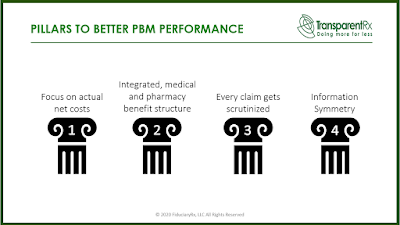 |
| Click to Learn More |
Reference Pricing: “Gross” Invoice Cost vs. AWP for Popular Generic and Brand Prescription Drugs (Volume 331)
Step #4: Now take it one step further. Check what your organization has paid, for prescription drugs, against our acquisition costs then determine if a problem exists. When there is more than a 5% price differential for brand drugs or 25% (paid versus actual cost) for generic drugs we consider this a potential problem thus further investigation is warranted.
Multiple price differential discoveries mean that your organization or client is likely overpaying. REPEAT these steps once per month.
— Tip —
Tuesday Tip of the Week: Increase out-of-pocket (OOP) spending for specialty drugs
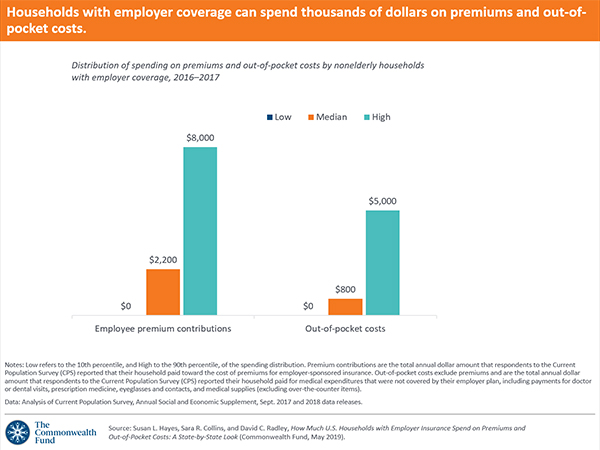
Reference Pricing: “Gross” Invoice Cost vs. AWP for Popular Generic and Brand Prescription Drugs (Volume 330)
Step #4: Now take it one step further. Check what your organization has paid, for prescription drugs, against our acquisition costs then determine if a problem exists. When there is more than a 5% price differential for brand drugs or 25% (paid versus actual cost) for generic drugs we consider this a potential problem thus further investigation is warranted.
Multiple price differential discoveries mean that your organization or client is likely overpaying. REPEAT these steps once per month.
— Tip —
- Go to the previous page
- 1
- …
- 48
- 49
- 50
- 51
- 52
- 53
- 54
- …
- 144
- Go to the next page


